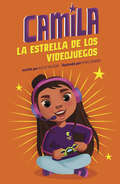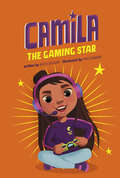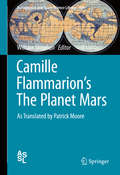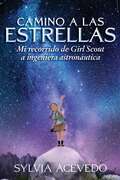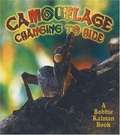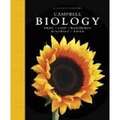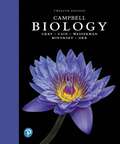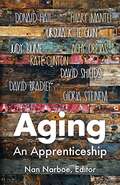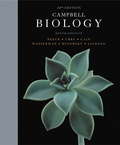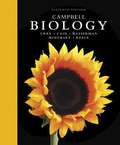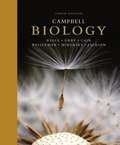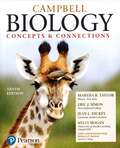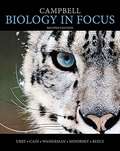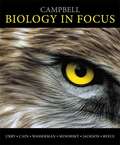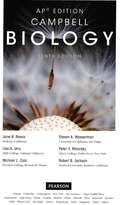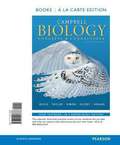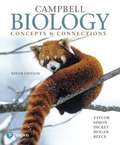- Table View
- List View
Camila la estrella de los videojuegos (Camila la estrella)
by Alicia SalazarCamila quiere comprar nuevos equipos de video, y cuando se entera de un torneo de videojuegos, ve la oportunidad de ganar mucho dinero. Sus hermanos la ayudan a perfeccionar su técnica de juego, pero ¿será suficiente para ganar y convertirse en la estrella de los videojuegos?
Camila the Gaming Star (Camila the Star)
by Alicia SalazarCamila wants to buy some new video equipment, so when she hears about a video game tournament, she sees her chance to win big money. Her brother and sister help her perfect her gaming skills, but will it be enough to make her into a winning video game star?
Camille Flammarion's The Planet Mars: As Translated by Patrick Moore (Astrophysics and Space Science Library #409)
by Camille Flammarionwilliam SheehanCamille Flammarion (1842-1925) began his career at 16 as a human computer under the great mathematician U. J. J. Le Verrier at the Paris Observatory. He soon tired of the drudgery; he was drawn to more romantic vistas, and at 19 wrote a book on an idea that he was to make his own--the habitability of other worlds. There followed a career as France's greatest popularizer of astronomy, with over 60 titles to his credit. An admirer granted him a chateau at Juvisy-sur-l'Orge, and he set up a first-rate observatory dedicated to the study of the planet Mars. Finally, in 1892, he published his masterpiece, La Planete Mars et ses conditions d'habitabilite, a comprehensive summary of three centuries' worth of literature on Mars, much of it based on his own personal research into rare memoirs and archives. As a history of that era, it has never been surpassed, and remains one of a handful of indispensable books on the red planet. Sir Patrick Moore (1923-2012) needs no introduction; his record of popularizing astronomy in Britain in the 20th century equaled Flammarion's in France in the 19th century. Moore pounded out hundreds of books as well as served as presenter of the BBC's TV program "Sky at Night" program for 55 years (a world record). Though Moore always insisted that the Moon was his chef-d'oeuvre, Mars came a close second, and in 1980 he produced a typescript of Flammarion's classic. Unfortunately, even he found the project too daunting for his publish ers and passed the torch of keeping the project alive to a friend, the amateur astronomer and author William Sheehan, in 1993. Widely regarded as a leading historian of the planet Mars, Sheehan has not only meticulously compared and corrected Moore's manuscript against Flammarion's original so as to produce an authoritative text, he has added an important introduction showing the book's significance in the history of Mars studies. Here results a book that remains an invaluable resource and is also a literary tour-de-force, in which the inimitable style of Flammarion has been rendered in the equally unique style of Moore.
Camino a las estrellas (Path to the Stars Spanish edition): mi recorrido de Girl Scout a ingeniera astronáutica
by Sylvia Acevedo Isabel MendozaUna familia cariñosa, un vecindario repleto de niños y una mamá que cantaba todo el día… Sylvia Acevedo amaba todo lo que tenía en la vida. Un día se enfermó su hermanita, y todo cambió.Mientras su familia luchaba por salir adelante después de esa devastadora enfermedad, la vida de la pequeña Sylvia se transformó cuando ingresó a las Brownies. En Girl Scouts le enseñaron a crear sus propias oportunidades. La ayudaron a planificar su futuro y alimentaron su amor por los números y la ciencia.Con renovada seguridad, Sylvia navegó a través de las diferentes expectativas culturales de su escuela y su hogar, abriéndose su propio camino hasta convertirse en una de lxs primerxs latinx en obtener una maestría en ingeniería de la Universidad de Stanford y en una de las pocas ingenieras astronáuticas en el Laboratorio de Propulsión a Chorro de la NASA. ¡Disponible en español y ingles! Sylvia Acevedo es actualmente la Directora Ejecutiva de Girl Scouts de Estados Unidos. Su inspiradora historia, contada con calidez y perspicacia, alienta a los lectores a soñar en grande y a convertir sus sueños en realidad.
Camouflage
by Karen KlozenbucherWhile Lydia and Ryan play hide-and-seek, they find animals that seem to disappear before their eyes! Learn about camouflage and the cool way it helps animals—and people, too!—blend into their surroundings. Will Ryan be able to find Lydia after she camouflages herself?
Camouflage: Changing to Hide (Nature's changes series)
by Bobbie KalmanIt looks at camouflage as colors, patterns, and textures that some animals have on their bodies to protect them from predators. It also shows how other animals use camouflage to hide as they hunt for prey.
Campbell Biology
by Jane B. Reece Michael L. Cain Peter V. Minorsky Lisa A. Urry Steven A. WassermanThe Eleventh Edition of the best-selling Campbell BIOLOGY sets students on the path to success in biology through its clear and engaging narrative, superior skills instruction, innovative use of art and photos, and fully integrated media resources to enhance teaching and learning. <p><p> To engage learners in developing a deeper understanding of biology, the Eleventh Edition challenges them to apply their knowledge and skills to a variety of new hands-on activities and exercises in the text and online. Content updates throughout the text reflect rapidly evolving research, and new learning tools include Problem-Solving Exercises, Visualizing Figures, Visual Skills Questions, and more.
Campbell Biology
by Lisa UrryWe are honored to present the Twelfth Edition of Campbell Biology. For the last three decades, Campbell Biology has been the leading college text in the biological sciences. It has been translated into 19 languages and has provided millions of students with a solid foundation in college-level biology. This success is a testament not only to Neil Campbell's original vision but also to the dedication of hundreds of reviewers (listed on pages xxviii-xxxi), who, together with editors, artists, and contributors, have shaped and inspired this work. Our goals for the Twelfth Edition include: * supporting students with new visual presentations of content and new study tools * supporting instructors by providing new teaching modules with tools and materials for introducing, teaching, and assessing important and often challenging topics * integrating text and media to engage, guide, and inform students in an active process of inquiry and learning Our starting point, as always, is our commitment to craft¬ing text and visuals that are accurate, are current, and reflect our passion for teaching biology.
Campbell Biology (9th Edition)
by Jane B. ReeceBiology is an enormous subject, one that can seem over¬whelming to students and scientists alike. Moreover, dis¬coveries are being made at an unprecedented pace--from new kinds of small RNA molecules to the Neanderthal genome, from new biofuels to communities of organisms thriving be¬neath vast glaciers, from emerging infectious diseases to can¬cer vaccines. As a result, a general biology course faces a daunting challenge: to keep students from suffocating under an avalanche of information. CAMPBELL BIOLOGY addresses this challenge by providing a strong foundation for under¬standing both current knowledge and new developments in the context of underlying biological concepts.
Campbell Biology (AP 9th Edition)
by Jane B. Reece Michael L. Cain Lisa A. UrryAdvanced placement biology textbook
Campbell Biology (AP 9th Edition)
by Jane B. Reece Michael L. Cain Lisa A. UrryAdvanced placement biology textbook
Campbell Biology (Eleventh Edition)
by Jane B. Reece Michael L. Cain Peter V. Minorsky Lisa A. Urry Steven A. WassermanTo engage learners in developing a deeper understanding of biology, the Eleventh Edition challenges them to apply their knowledge and skills to a variety of new hands-on activities and exercises in the text and online. Content updates throughout the text reflect rapidly evolving research, and new learning tools include Problem-Solving Exercises, Visualizing Figures, Visual Skills Questions, and more.
Campbell Biology (TenthEdition)
by Jane B. Reece Robert B. Jackson Michael L. Cain Peter V. Minorsky Lisa A. Urry Steven A. WassermanThe Tenth Edition of the best-selling text Campbell BIOLOGY helps launch you to success in biology through its clear and engaging narrative, superior pedagogy, and innovative use of art and photos to promote student learning. The Tenth Edition helps you develop a deeper understanding of biology by making connections visually across chapters and building the scientific skills needed for success in upper-level courses. New Make Connections Figures pull together content from different chapters visually, helping you see "big picture" relationships. New Scientific Skills Exercises in every chapter use real data to build key skills needed for biology, including data analysis, graphing, experimental design, and math skills. New examples show you how our ability to sequence DNA and proteins rapidly and inexpensively is transforming every subfield of biology.
Campbell Biology Concepts and Connections
by Eric J. Simon Jane B. Reece Martha R. Taylor Jean L. Dickey Kelly A. HoganCampbell Biology Concepts and Connections - 10th NASTA edition
Campbell Biology In Focus
by Jane B. Reece Michael L. Cain Peter V. Minorsky Lisa A. Urry Steven Alexander WassermanCampbell Biology In Focus
Campbell Biology In Focus
by Jane B. Reece Michael L. Cain Peter V. Minorsky Lisa A. Urry Steven Alexander WassermanCampbell Biology in Focus is the best-selling “short” textbook for the introductory college biology course for science majors. Every unit takes an approach to streamlining the material that best fits the needs of instructors, based on surveys, curriculum initiatives, reviews, discussions with hundreds of biology professors, careful analyses of course syllabi, and the report Vision and Change in Undergraduate Biology Education. The Second Edition builds on the Campbell hallmark standards of accuracy, clarity, and pedagogical innovation, going beyond this foundation to help students make connections visually across chapters, interpret real data from research, and synthesize their knowledge.The accompanying digital resources include new, mobile-friendly tools that help instructors teach challenging topics better than ever before; integrate the eText with videos and animations; and allow students to test, learn, and retest until they achieve mastery of the content.
Campbell Biology In Focus
by Lisa UrryThe snow leopard (Panthera uncia) that peers intently from the cover of this book has a suite of evolutionary adaptations that enable it to spot, track, and ambush its prey. The snow leopard's keen eye is a metaphor for our goal in writing this text: to focus with high intensity on the core concepts and scientific skills AP Biology students need to succeed.
Campbell Biology In Focus
by Lisa Urry*This textbook has been transcribed in UEB, formatted according to Braille textbook formats, proofread and corrected. <P><P>The snow leopard (Panthera uncia) that peers intently from the cover of this book has a suite of evolutionary adaptations that enable it to spot, track, and ambush its prey. The snow leopard's keen eye is a metaphor for our goal in writing this text: to focus with high intensity on the core concepts and scientific skills AP Biology students need to succeed.
Campbell Biology In Focus (AP Edition)
by Jane B. Reece Robert B. Jackson Michael L. Cain Peter V. Minorsky Lisa A. Urry Steven A. WassermanBiology in Focus explores the following units: UNIT 1 Chemistry and Cells UNIT 2 Genetics UNIT 3 Evolution UNIT 4 The Evolutionary History of Life UNIT 5 Plant Form and Function UNIT 6 Animal Form and Function UNIT 7 Ecology
Campbell Biology in Focus
by Jane B. Reece Robert B. Jackson Michael L. Cain Peter V. Minorsky Lisa A. Urry Steven A. WassermanIn 900 text pages, Campbell Biology in Focus emphasizes the essential content and scientific skills needed for success in the college introductory course for biology majors. Each unit streamlines content to best fit the needs of instructors and students, based on surveys, curriculum initiatives, reviews, discussions with hundreds of biology professors, and careful analyses of course syllabi. Every chapter includes a Scientific Skills Exercise that builds skills in graphing, interpreting data, experimental design, and math--skills biology majors need in order to succeed in their upper-level courses. This briefer book upholds the Campbell hallmark standards of accuracy, clarity, and pedagogical innovation.
Campbell Biology in Focus
by Lisa Urry Michael Cain Peter Minorsky Steven Wasserman Rebecca OrrBuilt unit-by-unit, Campbell Biology in Focus achieves a balance between breadth and depth of concepts to move students away from memorization. Streamlined content enables students to prioritize essential biology content, concepts, and scientific skills that are needed to develop conceptual understanding and an ability to apply their knowledge in future courses. Every unit takes an approach to streamlining the material to best fit the needs of instructors and students, based on reviews of over 1,000 syllabi from across the country, surveys, curriculum initiatives, reviews, discussions with hundreds of biology professors, and the Vision and Change in Undergraduate Biology Education report. <p><p> Maintaining the Campbell hallmark standards of accuracy, clarity, and pedagogical innovation, the 3rd Edition builds on this foundation to help students make connections across chapters, interpret real data, and synthesize their knowledge. The new edition integrates new, key scientific findings throughout and offers more than 450 videos and animations in Mastering Biology and embedded in the new Pearson eText to help students actively learn, retain tough course concepts, and successfully engage with their studies and assessments.
Campbell Biology: AP Edition
by Jane B. Reece Robert B. Jackson Michael L. Cain Peter V. Minorsky Lisa A. Urry Steven A. WassermanCAMPBELL BIOLOGY, AP EDITION 10th Edition
Campbell Biology: Concepts And Connections 8th Edition
by Eric J. Simon Jane B. Reece Martha R. Taylor Jean L. Dickey Kelly A. HoganCampbell Biology: Concepts & Connections continues to introduce pedagogical innovations, which motivate you not only to learn, but also engage with biology. The Eighth Edition of this market-leading book builds on its hallmarks of accuracy, currency, and a dedication to revolutionizing teaching and learning solutions. This thorough revision focuses on providing instructors with the resources needed to invigorate the course and gives you the tools you need to succeed. This edition includes many new key figures to help you better visualize tough topics, while an increased emphasis on scientific thinking equips you to leave the course thinking like a scientist.
Campbell Biology: Concepts and Connections
by Eric J. Simon Jane B. Reece Martha R. Taylor Jean L. DickeyThis book was the first biology textbook to use concept modules to help students recognize and focus on the main ideas of each chapter. This book connects every single chapter to evolution, with highlights featured in green-tabbed Evolution Connection modules.
Campbell Biology: Concepts and Connections
by Eric J. Simon Jane B. Reece Martha R. Taylor Jean L. Dickey Kelly Hogan"New Features of the ninth edition of Campbell Biology: Concepts and Connections provide students with a framework for understanding biological concepts and encourage students to see connections between concepts and the world outside of the classroom.
